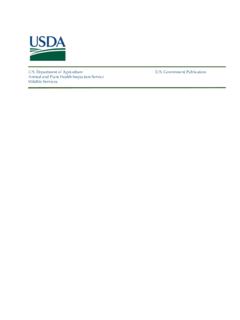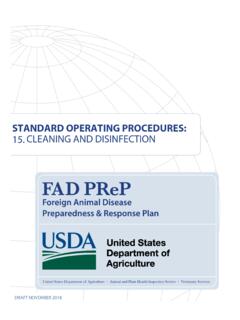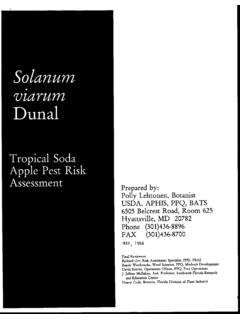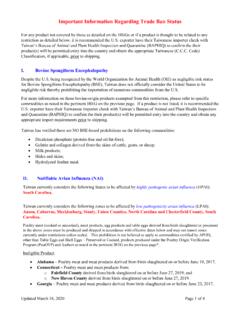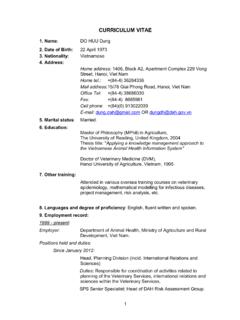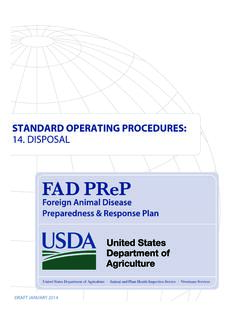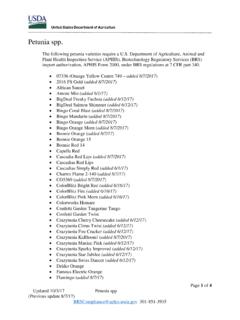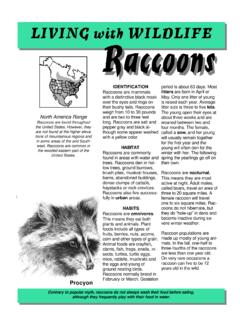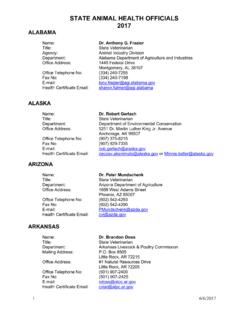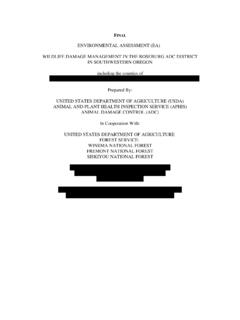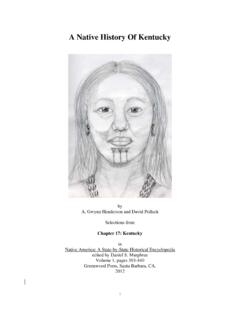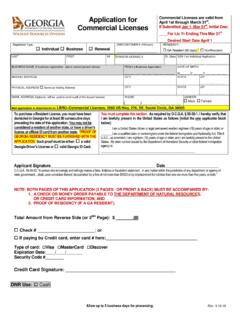Transcription of Muskrats - USDA
1 James E. Miller Professor Emeritus Mississippi State University Starkville, Mississippi Human-Wildlife Conflicts The muskrat (Ondatra zibethicus) is a common, semi-aquatic rodent native to the United States (Figure 1). It spends its life in aquatic habitats and is well adapted for swimming. Although Muskrats are an important part of native ecosystems, their burrowing and foraging activities can damage agricultural crops, native marshes and water control systems, such as aquaculture and farm ponds and levees. Such damage can significantly impact agricultural crops like rice that rely on consistent water levels for growth. Muskrats also cause damage by eating agricultural crops, other vegetation, and crayfish, mussels and other aquaculture products.
2 Loss of vegetation from muskrat foraging can impact marsh viability and habitats for other species, including waterfowl. Habitat restoration often takes years, negatively impacting fish and wildlife. Economic losses due to muskrat damage in Arkansas, California, Louisiana and Mississippi likely exceed most other states combined, primarily because of the vast amounts of productive marshlands and types of crops ( , rice, fish, crayfish and vegetable crops) grown in those states. Wildlife Damage Management Technical Series Department of Agriculture Animal & Plant Health Inspection Service Wildlife Services January 2018 Muskrats Figure 1. Muskrat (Ondatra zibethicus) Quick Links Human-Wildlife Conflicts 1 Damage Identification 2 Management Methods 3 Economics 5 Species Overview 6 Legal Status 10 Glossary & Key Words 11 Resources 12 Appendix 13 Landscapes Muskrat damage to agricultural crops and aquaculture can significantly impact crop yields and economic investments.
3 In states where damage occurs, regulations regarding the lethal removal of Muskrats is often relaxed to allow for damage control. Marshland habitats (Figure 2) and their associated wildlife communities can be substantially changed when muskrat populations erupt leading to eat-outs. Eat-outs are areas where vegetation is completely removed due to foraging by Muskrats . These areas may take several years to recover. Structures Muskrat burrowing can cause structural damage to dams, dikes, railroad/road beds and levees. Erosion due to muskrat burrows and dens may cause cave-ins and the collapse of some structures. The economic impact can be substantial to aquaculture facilities, if levees or water sources are impacted. Human Health and Safety Muskrats can carry and transmit several infectious diseases to people.
4 Of most concern is tularemia, a bacterial disease that is transmitted through contaminated water, infected meat or an open cut. Signs of tularemia infection include lethargy, fever, flu-like symptoms and infected sores. Tularemia can be life-threatening to people and proper protective gear ( , rubber gloves) should be worn when handling Muskrats . Muskrats also serve as reservoirs for numerous other diseases including hemorrhagic disease, leptospirosis, ringworm disease and pseudotuberculosis. In addition, Muskrats can carry parasites, such as tapeworms, roundworms, flukes, ticks and mites. Rarely do Muskrats attack people unless captured. Use caution when handling live Muskrats as they will bite and scratch with their clawed feet. Damage Identification Muskrat damage includes chew marks or stripped bark on trees, and partially eaten stalks on agricultural crops or wetland vegetation, such as cattails, sedges and water lilies.
5 Where freshwater mussels are eaten by Muskrats , caches of mussel shells can be found on vegetation rafts or near resting and feeding sites used by Muskrats . Depending upon site conditions, Muskrats either dig dens in steep banks or build dome-shaped lodges in open water using vegetation and mud (Figure 3). Burrowing may not be evident until serious damage has occurred. Signs of muskrat damage to banks from their burrowing activities include burrow entrances, erosion and cave-ins. One way to observe early burrowing is to walk along the edge of the dam or shoreline when the water is clear and look for runs or trails from just below the surface of the water to as deep as 3 feet. Several other aquatic mammal species ( , American beaver (Castor canadensis), nutria (Myocaster coypus) and river otter (Lutra canadensis)) may inhabit the same rivers, streams, lakes, ponds and marshes as Muskrats .
6 Muskrat damage can be distinguished from these other species damage by the type of vegetation and animal matter consumed. Also look for differences in the size of the animals tracks or droppings, the size and locations of Figure 2. Typical marshland habitat where muskrat may be found. Page 2 WDM Technical Series Muskrats burrows, the type of lodges/houses built, and other behavioral and physiological characteristics (See section on Physical Description for more information). Most muskrat damage is caused by their burrowing into pond dams, levees, aquaculture structures and other sites. Other damage includes foraging on grain crops, particularly rice, occasional vegetation eat-outs, and gnawing into floatation materials or structures around boat docks or platforms.
7 Unlike other species, such as beaver, Muskrats do not build dams, cut down trees, stop up culverts and pipes or create lodges from gnawed down trees and limbs. Muskrat do not cut down small trees, sugar cane or corn stalks like nutria and beaver do in some areas. River otter damage is most often associated with predation on fish and other aquatic species in farm ponds and aquaculture facilities. Muskrat burrow entrances are typically no larger than 5 to 6 inches (12 to 15 cm) in diameter, whereas beaver and nutria burrow entrances can be 14 to 20 inches (35 to 50 cm) in diameter. Management Methods No single management method to prevent muskrat damage works all the time or in all settings. Generally, management methods should be combined so that one method enhances the effects of another.
8 Timing of control efforts is important. For instance, prime fur trapping season for Muskrats is in the fall and winter when the Muskrats coats are thick. This coincides with a decrease in open water habitats that Muskrats depend upon. Thus, the trapping of Muskrats during winter is not only economically worthwhile, but also easier since overwintering habitats are limited. Winter trapping also helps reduce the number of Muskrats likely to cause damage the following spring. Habitat Modification The best way to modify the habitat to prevent muskrat damage is to eliminate aquatic vegetation or other suitable foods eaten by Muskrats . This can be done using prescribed burns to reduce marsh vegetation. Modifying the habitat by depleting water storage canals used for irrigation when no longer needed and removing water from rice fields after harvest can reduce muskrat overwintering habitat and make trapping more effective.
9 If farm ponds or levees are impacted by Muskrats , draw down the pond s water level at least 2 feet below normal, then fill dens, burrows and runs, and rip-rap the dam with stone. Exclusion Excluding Muskrats from areas is difficult given the varied habitats they use. Fencing or other barriers may be worthwhile to prevent damage to specialty crops or urban and suburban lawns that are adjacent to aquatic habitats. Fertility Control None available. Frightening Devices Although some commercial frightening devices are available, they typically are not effective at preventing muskrat damage. Page 3 Department of Agriculture Figure 3. Muskrat lodge made of vegetation and mud. Toxicants The only toxicant currently registered by the Environmental Protection Agency for use on aquatic rodents is Zinc Phosphide Concentrate (EPA Reg.)
10 No. 56228-6). It must also be registered in the state of intended use. This toxicant can be used with bait materials, such as apples, carrots, pears and sweet potatoes, and made accessible to Muskrats by placing near burrows or on floating feeding stations. Before using, carefully read and follow label instructions and use restrictions. Trapping Trapping is commonly used for reducing muskrat damage. A variety of traps exist including foothold traps, colony traps and body-gripping traps. Effectiveness is dependent upon the trapper s skill, knowledge of muskrat behavior, trap type used and persistence. There are many commercially available baits and lures for attracting Muskrats to trap sets, such as feed bed sets. Page 4 WDM Technical Series Muskrats Figure 4.
